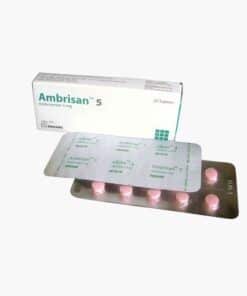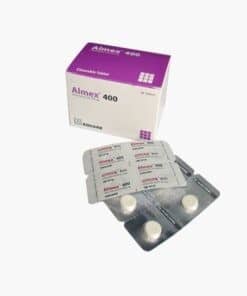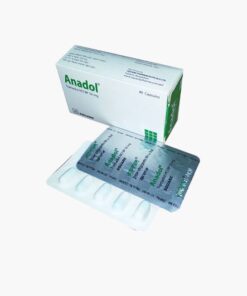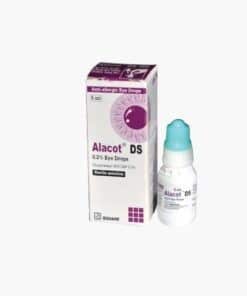Tritace | 5 mg | Tablet | 14 pcs
৳ 196.56
Brand Name: Tritace Tablet
Generic: Ramipril
5 mg
Manufacturer: Sanofi Bangladesh Ltd.
Unit Price: ৳ 14.04 (2 x 14: ৳ 393.12)
Strip Price: ৳ 196.56
Indications
Ramipril indicated in the following cases:
- Hypertension; to lower blood pressure, as single-drug therapy or in combination with other antihypertensive agents.
- Congestive heart failure; also in combination with diuretics.
- Treatment of patients who- within the first few days after an acute myocardial infarction- have demonstrated clinical signs of congestive heart failure.
- Treatment of non-diabetic or diabetic overt glomerular or incipient nephropathy.
- Reduction in the risk of myocardial infarction, stroke, or cardiovascular death in patients with an increased cardiovascular risk, such as manifest coronary heart disease (with or without a history of myocardial infarction), a history of stroke, a history of peripheral vascular disease, or diabetes mellitus that is accompanied by at least one other cardiovascular risk factor (microalbuminuria, hypertension, elevated total cholesterol levels, low high-density lipoprotein cholesterol levels, smoking).
Pharmacology
Dosage
Dosage of Ramipril must be adjusted according to the patient tolerance and response.
Hypertension: For the management of hypertension in adults not receiving a diuretic, the usual initial dose of Ramipril is 1.25-2.5 mg once daily. Dosage generally is adjusted no more rapidly than at 2 week intervals. The usual maintenance dosage in adults is 2.5-20 mg daily given as a single dose or in 2 divided doses daily. If BP is not controlled with Ramipril alone, a diuretic may be added.
Congestive heart failure after myocardial infarction: In this case, Ramipril therapy may be initiated as early as 2 days after myocardial infarction. An initial dose of 2.5 mg twice daily is recommended, but if hypotension occurs, dose should be reduced to 1.25 mg twice daily. Therapy is then titrated to a target daily dose of 5 mg twice daily.
Prevention of major cardiovascular events: In this case, the recommended dose is 2.5 mg once daily for the first week of therapy and 5 mg once daily for the following 3 weeks; dosage then may be increased, as tolerated, to a maintenance dosage of 10 mg once daily.
Dosage in renal impairment:
- For patients with hypertension and renal impairment: The recommended initial dose is 1.25 mg Ramipril once daily. Subsequent dosage should be titrated according to individual tolerance and BP response, up to a maximum of 5 mg daily.
- For patients with heart failure and renal impairment: The recommended dose is 1.25 mg once daily. The dose may be increased to 1.25 mg twice daily and up to a maximum dose of 2.5 mg twice daily depending upon clinical response and tolerability.
Administration
Interaction
Contraindications
Ramipril must not be used
- in patients with hypersensitivity to ramipril, to any other ACE inhibitor, or any of the excipients of Ramipril.
- in patients with a history of angioedema.
- concomitantly with sacubitril/valsartan therapy. Do not initiate Ramipril until sacubitril/valsartan is eliminated from the body. In case of switch from Ramipril to sacubitril/valsartan, do not start sacubitril/valsartan until Ramipril is eliminated from the body.
- in patients with haemodynamically relevant renal artery stenosis, bilateral or unilateral in the single kidney.
- in patients with hypotensive or haemodynamically unstable states.
- with aliskiren-containing medicines in patients with diabetes or with moderate to severe renal impairment (creatinine clearance <60 ml/min).
- with angiotensin II receptor antagonists (AIIRAs) in patients with diabetic nephropathy.
- during pregnancy.
Concomitant use of ACE inhibitors and extracorporeal treatments leading to contact of blood with negatively charged surfaces must be avoided, since such use may lead to severe anaphylactoid reactions. Such extracorporeal treatments include dialysis or haemofiltration with certain high-fux (e.g. polyacrylonitril) membranes and low-density lipoprotein apheresis with dextran sulfate.
Side Effects
Pregnancy & Lactation
Precautions & Warnings
Use in Special Populations
Elderly: A reduced initial dose of 1.25 mg Ramipril daily must be considered.
Hepatic impairment: Treatment in these patients must therefore be initiated only under close medical supervision. The maximum permitted daily dose in such cases is 2.5 mg Ramipril.
Renal impairment: With a creatinine clearance between 50 and 20 ml/min per 1.73 m2 body surface area, the initial daily dose is generally 1.25 mg Ramipril. The maximum permitted daily dose, in this case, is 5 mg Ramipril. Patients with incompletely corrected fuid or salt depletion, in patients with severe hypertension, as well as in patients in whom a hypotensive reaction would constitute a particular risk, (e.g., with relevant stenoses of the coronary vessels or those supplying the brain) A reduced initial dose of 1.25 mg Ramipril daily must be considered.
Patients pretreated with a diuretic: Consideration must be given to discontinuing the diuretic for at least 2 to 3 days or- depending on the duration of action of the diuretic- longer before starting treatment with Ramipril, or at least to reducing the diuretic dose. The initial daily dose in patients previously treated with a diuretic is generally 1.25 mg Ramipril.
Overdose Effects
Sign and symptom: Overdosage may cause excessive peripheral vasodilatation (with marked hypotension, shock), bradycardia, electrolyte disturbances, and renal failure.
Management: Primary detoxifcation by, for example, gastric lavage, administration of adsorbents, sodium sulfate; (if possible during the frst 30 minutes). In the event of hypotension administration of α1-adrenergic agonists (e.g. norepinephrine, dopamine) or angiotensin II (angiotensinamide), which is usually available only in scattered research laboratories, must be considered in addition to volume and salt substitution.
Therapeutic Class
Storage Conditions
| Generic Name | Ramipril |
|---|---|
| Tablet | 5 mg |
Only logged in customers who have purchased this product may leave a review.












Reviews
There are no reviews yet.